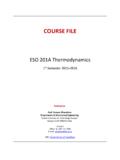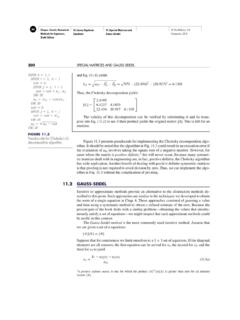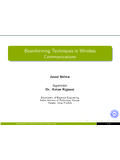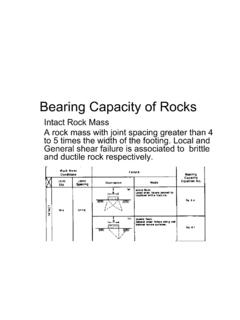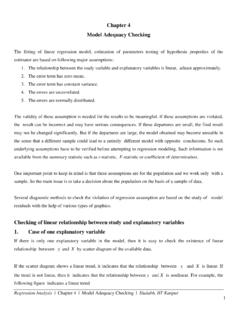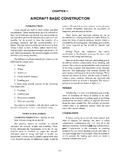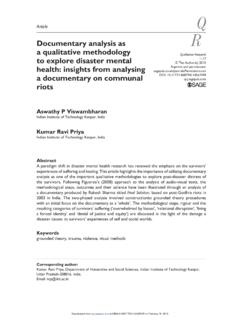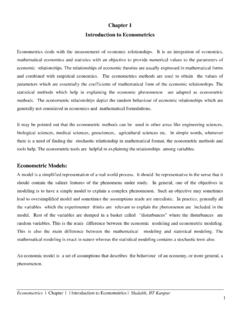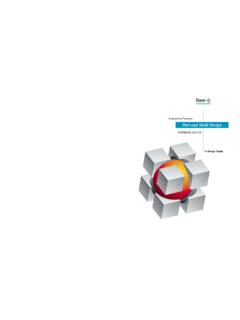Transcription of Additive Manufacturing - IIT Kanpur
1 Additive ManufacturingProf. J. RamkumarDepartment of Mechanical EngineeringIIT KanpurOctober 3, 2017 OutlineIntroduction to Additive ManufacturingClassification of Additive Manufacturing SystemsIntroduction to Reverse EngineeringAdditive ManufacturingIAdditive Manufacturing (AM) refers to a process by whichdigital 3D design data is used to build up a component inlayers by depositing term AM encompasses many technologies includingsubsets like 3D Printing, Rapid Prototyping (RP), DirectDigital Manufacturing (DDM), layered Manufacturing andadditive application is limitless. Early use of AM in the form ofRapid Prototyping focused on preproduction visualizationmodels. More recently, AM is being used to fabricate end-useproducts in aircraft, dental restorations, medical implants,automobiles, and even fashion Manufacturing structure of Additive Manufacturing and itssubcategoriesSome ExamplesSome Examples Examples Examples vs Subtractive ManufacturingAdditive vs Subtractive Manufacturing of AM TechnologiesEvolution of AM Technologies and Potential industries for AdditiveManufacturingPros and Cons of AMAM Benefits: Weight ReductionAM Benefits: Complexity for FreeAM Benefits: Customized Medical ProductsFuture.
2 Home ManufacturingGeneric AM ProcessGeneric AM Process path for Additive manufacturingGeneration of Geometrical Layer Information on SingleLayersITo produce three-dimensional models by layer-orientedadditive Manufacturing processes, the 3D CAD solid must bemathematically split into the same layers as those producedphysically by the AM machine. This process is known as slicing. IThere are two basic methods of doing this:1) Triangulation, which leads to the STL format2) Direct cutting in the CAD system, which leads to the CL(SLI) formatSTL formatISTL (STereoLithography) is a file format native to thestereolithography CAD is widely used for rapid prototyping, 3D printing andcomputer-aided main purpose of the STL file format is to encode thesurface geometry of a 3D encodes this information using a simple concept called tessellation .TessellationITessellation is the process of tiling a surface with one or moregeometric shapes such that there are no overlaps or can involve simple geometric shapes or verycomplicated (and imaginative) vs.
3 Invalid Tessellated ModelsExploiting tessellation to encode surface geometryIThe basic idea is to tessellate the 2 dimensional outer surfaceof 3D models using tiny triangles (also called facets ) andstore information about the facets in a example, if you have a simple 3D cube, this can becovered by 12 triangles and 3D model of a sphere, then it canbe covered by many small triangles, as shown in the tessellation to encode surface geometry is another example of a very complicated 3D shapewhich has been tessellated with does an STL file store information about facets?IThe STL file format provides two different ways of storinginformation about the triangular facets that tile the ) ASCII encoding2) The binary encodingIIn both formats, the following information of each triangle isstored:1) The coordinates of the ) The components of the unit normal vector to the normal vector should point outwards with respect to the3D ASCII STL file formatIThe ASCII STL file starts with the mandatory line:solid<name>IThe file continues with information about the coveringtriangles.
4 Information about the vertices and the normalvector is represented as follows:facet normal nx ny nzouter loopvertex v1x v1y v1zvertex v2x v2y v2zvertex v3x v3y v3zendloopendfacetIHere, n is the normal to the triangle and v1, v2 and v3 are thevertices of the file ends with the mandatory line:endsolid<name>The binary STL file formatIIf the tessellation involves many small triangles, the ASCIISTL file can become huge. This is why a more compactbinary version binary STL file starts with a 80 character [80] - HeaderUINT32 - Number of trianglesIThe information about the triangles follow subsequently. Thefile simply ends after the last triangleREAL32[3] - Normal vectorREAL32[3] - Vertex 1 REAL32[3] - Vertex 2 REAL32[3] - Vertex 3 UINT16 - Attribute byte countendSpecial rules for the STL formatIThe STL specification has some special rules for tessellationand for storing vertex rule:The vertex rule states that each trianglemust share two vertices with its neighboring rules for the STL format orientation rule:The orientation rule says that theorientation of the facet ( which way is in the 3D objectand which way is out ) must be specified in two triangle sorting rule:The triangle sorting rulerecommends that the triangles appear in ascending all positive octant rule.
5 The all positive octant rulesays that the coordinates of the triangle vertices must all an STL file for best 3D printing performanceIThe STL file format approximates the surface of a CADmodel with approximation is never perfect, and the facets introducecoarseness to the is therefore very important to find the right balancebetween file size and print and Disadvantages of STL File FormatClassification of Additive Manufacturing SystemsIThe Better way is to classify AM systems broadly by theinitial form of its material, all AM Systems can be easilycategorised into1) Liquid Based2) Solid Based3) Powder BasedClassification of Additive Manufacturing SystemsLiquid Based Additive Manufacturing SystemsIBuilding material is in the liquid following AM Systems fall into this category:1) Stereolithography Apparatus(SLA)2) PolyJet 3D printing3) Multijet Printing(MJP)4) Solid Object Ultravoilet-Laser Printer(SOUP)5) Rapid Freeze PrototypingI1) and 4) are widely used Based Additive Manufacturing SystemsIBuilding material is in the Solid state (except powder).
6 IThe solid form can include the shape in the forms of wire,rolls, laminates and following AM Systems fall into this category:1) Fused deposition modeling (FDM)2) Selective Deposition Lamination (SDL)3) Laminated Object Manufacturing (LOM)4) Ultrasonic ConsolidationPowder Based Additive Manufacturing SystemsIBuilding material is Powder(grain like form).IAll Powder Based AM Systems employ the following AM Systems fall into this category:1) Selective Laser Sintering(SLS)2) ColorJet Printing(CJP)3) Laser Engineered Net Shaping (LENS)4) Electron Beam Melting(EBM) Technologies of AMIIn the next few slides, we are going to discuss these three AMtechnologies1) Stereolithography Apparatus(SLA)2) Fused deposition modeling (FDM)3) Selective Laser Sintering(SLS)StereolithographyIOne of the most important Additive manufacturingtechnologies currently first ever commercial RP systems were resin-basedsystems commonly called stereolithography or resin is a liquid photosensitive polymer that cures orhardens Stereolithography when exposed to technique involves the curing or solidification of a liquidphotosensitive polymer through the use of the irradiation source supplies the energy that is needed to induce achemical reaction ( curing reaction)
7 , bonding large no of smallmolecules and forming a highly cross-linked polymerStereolithography About SLA1) Each layer is mm to mm thick2) Starting materials are liquid monomers3) Polymerization occurs on exposure to UV light produced bylaser scanning beam- Scanning speeds - 500 to 2500 mm/sIPart Build Time in SLATime to complete a single layer :Ti=AivD+Td(1)whereTi= time to complete layer i;Ai= area of layer i;v=average scanning speed of the laser beam at the surface;D=diameter of the spot size , assumed circular; andTd= delaytime between layers to reposition the worktableStereolithography to build a part ranges from one hour for small parts ofsimple geometry up to several dozen hours for complex partsISLA Build Cycle Time :Tc=nl i=1Ti(2)whereTc= STL build cycle time; andnl= number of layersused to approximate the partSLA 3D Printing ProductFused deposition modelingIFused Deposition Modeling (FDM)
8 , produced and developedby Stratasys, uses a heating chamber to liquefy polymer that is fedinto the system as a filament is pushed into the chamber by a tractor wheelarrangement and it is this pushing that generates theextrusion major strength of FDM is in the range of materials andthe effective mechanical properties of resulting parts madeusing this made using FDM are amongst the strongest for anypolymerbased Additive Manufacturing deposition modeling for FDMIThe most popular material is the ABSplus material, which canbe used on all current Stratasys FDM machines also have an option for ABS blended for FDM that FDM works best with polymers that are amorphousin nature rather than the highly crystalline is because the polymers that work best are those that areextruded in a viscous paste rather than in a lower in amorphous polymers, there is no distinct melting pointand the material increasingly softens and viscosity lowers withincreasing viscosity at which these amorphous polymers can beextruded under pressure is high enough that their shape will belargely maintained after extrusion, maintaining the extrusionshape and enabling them to solidify quickly and of FDMIS harp features or corners not possible to get;IPart strength is weak perpendicular to build axis;IMore area in slices requires longer build times;ITemperature fluctuations during production could lead todelaminationFDM 3D Printing ProductSelective Laser SinteringSelective Laser Sintering thickness: nearly mm thick;IThe part building takes place inside an enclosed chamber filledwith nitrogen gas to minimize oxidation and degradation ofthe powdered material.
9 IThe powder in the building platform is maintained at anelevated temperature just below the melting point and/orglass transition temperature of the powdered material;IInfrared heaters are used to maintain an elevated temperaturearound the part being formed;IA focusedCO2laser beam is moved on the bed in such a waythat it thermally fuses the material to form the slicecross-section;ISurrounding powders remain loose and serve as support forsubsequent vs. disadvantages of SLSIA dvantages1) A distinct advantage of the SLS process is that because itis fully self-supporting2) Parts possess high strength and stiffness3) Good chemical resistance4) Various finishing possibilities ( , metallization, stoveenameling, vibratory grinding, tub coloring, bonding, powder,coating, flocking) 5) Complex parts with interior components,channels, can be built without trapping the material ) Fastest Additive Manufacturing processIDisadvantagesSLS printed parts have surface porosity.
10 Such porosity can besealed by applying sealant such as 3D Printing ProductIntroduction to Reverse EngineeringIIt is the processes of extracting knowledge or designinformation from anything man-made and reproducing it orreproducing anything based on the extracted process often involves disassembling something (amechanical device, electronic component, computer program,or biological, chemical, or organic matter) and analyzing itscomponents and workings in of World War for Reverse EngineeringIInterfacing:Reverse engineering can be used when a systemis required to interface to another or commercial espionage:Learning about anenemy s or competitor s latest research by stealing orcapturing a prototype and dismantling security analysis:To examine how a productworks, what are specifications of its components, estimatecosts and identify potential patent purposes:Reverse engineering forlearning purposes may be to understand the key issues of anunsuccessful design and subsequently improve the money:when one finds out what a piece ofelectronics is capable of, it can spare a user from purchase ofa separate Engineering ProcessIPredictionWhat is the purpose of this product?
